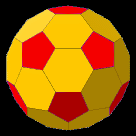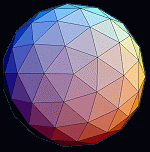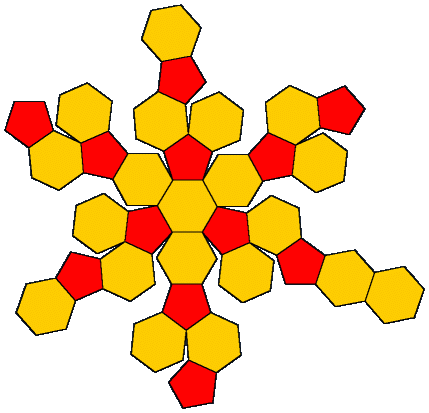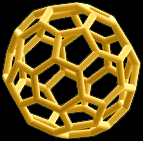Bucky balls are based on sixty coordinates all based on phi.
Bucky balls are named after Buckminster Fuller, who popularized the geodesic dome. The shape defined by Bucky balls is also found in the Carbon 60 molecule, a form of pure carbon with 60 atoms in a nearly spherical configuration, the truncated icosahedron and soccer balls.
Bucky balls consist of 60 points on the surface of a spherical shape where the distance from any point to its nearest neighboring three points on the sphere is identical for all points.
Bucky ball

Truncated
icosahedron

Soccer ball
(A very phine sport)

Geodesic dome
Note that the surface consists of twelve phi-based pentagons, each one of which is connected to five of the twenty hexagons, shown unfolded below:

In the geodesic dome, each pentagon and hexagon is divided into identically shaped triangles, bringing the shape closer yet to a sphere.
The coordinates of the 60 vertices of a Bucky ball centered on the origin of a 3D axis are all based on phi!
These coordintates are the same as the corners of the following three rectangles shown on the Geometry page:
(0,+-1,+-3Φ), (+-1,+-3Φ,0), (+-3Φ,0,+-1)
They also can be defined by the following six 3D bricks:
(+-2,+-(1+2Φ),+-Φ)
(+-(1+2Φ),+-Φ,+-2)
(+-Φ,+-2,+-(1+2Φ))
(+-1,+-(2+Φ),+-2Φ)
(+-(2+Φ),+-2Φ,+-1)
(+-2Φ,+-1,+-(2+Φ))
Here is a complete list of all the coordinates:
(0,1,3Φ)
(0,1,-3Φ)
(0,-1,3Φ)
(0,-1,-3Φ)
(1,3Φ,0)
(1,-3Φ,0)
(-1,3Φ,0)
(-1,-3Φ,0)
(3Φ,0,1)
(3Φ,0,-1)
(-3Φ,0,1)
(-3Φ,0,-1)
(2,(1+2Φ),Φ)
(2,(1+2Φ),-Φ)
(2,-(1+2Φ),Φ)
(2,-(1+2Φ),-Φ)
(-2,(1+2Φ),Φ)
(-2,(1+2Φ),-Φ)
(-2,-(1+2Φ),Φ)
(-2,-(1+2Φ),-Φ)
((1+2Φ),Φ,2)
((1+2Φ),Φ,-2)
((1+2Φ),-Φ,2)
((1+2Φ),-Φ,-2)
(-(1+2Φ),Φ,2)
(-(1+2Φ),Φ,-2)
(-(1+2Φ),-Φ,2)
(-(1+2Φ),-Φ,-2)
(Φ,2,(1+2Φ))
(Φ,2,-(1+2Φ))
(Φ,-2,(1+2Φ))
(Φ,-2,-(1+2Φ))
(-Φ,2,(1+2Φ))
(-Φ,2,-(1+2Φ))
(-Φ,-2,(1+2Φ))
(-Φ,-2,-(1+2Φ))
(1,(2+Φ),2Φ)
(1,(2+Φ),-2Φ)
(1,-(2+Φ),2Φ)
(1,-(2+Φ),-2Φ)
(-1,(2+Φ),2Φ)
(-1,(2+Φ),-2Φ)
(-1,-(2+Φ),2Φ)
(-1,-(2+Φ),-2Φ)
((2+Φ),2Φ,1)
((2+Φ),2Φ,-1)
((2+Φ),-2Φ,1)
((2+Φ),-2Φ,-1)
(-(2+Φ),2Φ,1)
(-(2+Φ),2Φ,-1)
(-(2+Φ),-2Φ,1)
(-(2+Φ),-2Φ,-1)
(2Φ,1,(2+Φ))
(2Φ,1,-(2+Φ))
(2Φ,-1,(2+Φ))
(2Φ,-1,-(2+Φ))
(-2Φ,1,(2+Φ))
(-2Φ,1,-(2+Φ))
(-2Φ,-1,(2+Φ))
(-2Φ,-1,-(2+Φ))
Thanks to Eric Manning for bringing this insight on bucky ball coordinates to my attention.



For the Truncated Icosahedron, if you divide the number of hexagons (20) by the number of pentagons (12) you get : 20/12= 1.666666667
how do you put a truncated icosahedron together
There have been several reports of C60 as an antioxidant,although there have also been reports that it can be cytotoxic via lipid peroxidation. (One difference was that that report was with aggregates of C60 in water, versus soluble C60 in oil, but there are other reports that hydrated C60 does the opposite: there’s clearly a lot that hasn’t been cleared up here).